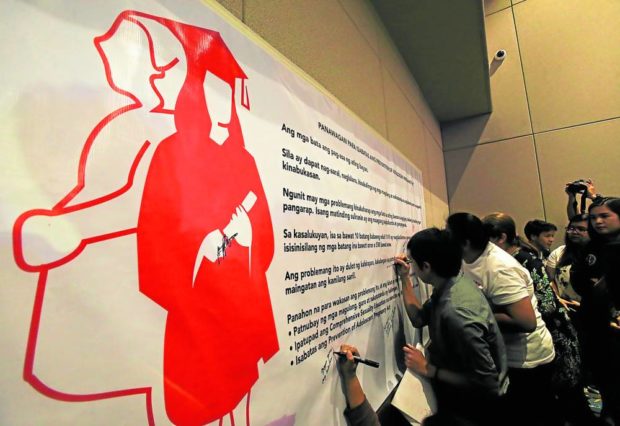More young Filipino are shunning premarital sex, study finds

YES TO SAFE SEX Fewer Filipino youth engage in premarital sex but more are using protection to prevent unwanted pregnancy, the same objective of the “No More Children Having Children” campaign in 2019. —LYN RILLON
MANILA, Philippines — Fewer young Filipinos are having sex before marriage and those who do will use a condom or other sexual protection for their first time, a nationwide survey by the University of the Philippines (UP) revealed.
But those who engage in “high-risk sexual activities”—such as one-night stands and transactional sex—are less likely to use protection, according to the 2021 Young Adult Fertility and Sexuality Study (YAFS5) by the UP Population Institute (UPPI).
Among other findings, the researchers saw a consistent rise in the number of 15- to 24-year-olds engaging in premarital sex from 18 percent in 1994 to 23 percent in 2002 and 32 percent in 2013.
But the upward trend stopped abruptly in 2021, a period marked by pandemic challenges, such as community quarantines and school closures: Only 22 percent of the respondents reported having premarital sex, the study found.
The difference observed between 2021 and the other survey years was more striking among young women than men.
Article continues after this advertisementMale youth saw an average increase of 5 percentage points over three polls conducted in 1994, 2002, and 2013, which recorded the highest level of premarital sex at 36 percent. In 2021, that dropped to 28 percent.
Article continues after this advertisementAmong female youth, the change was more dramatic.
From only 10 percent saying they had sex before marriage in 1994, the number had nearly tripled by 2013, two decades later, the study found.
Drastic drop
Then it “drastically dropped” to 16 percent in 2021, returning to the 2002 level, according to UPPI Associate Professor Maria Paz Marquez, who led the research on youth’s sexual behavior for the YAFS5 and reported her findings on Friday.
Marquez said the median age for the sexual initiation of both men and women was 18 years old.
But looking at the percentages of youth of both sexes who experienced sexual intercourse before reaching the legal age, the researchers saw a clear upward trend from 1994 to 2013, followed by a “reversal” in 2021, the professor said.
The study found that the use of condoms and other forms of protection during first premarital sex has risen considerably.
In 2013, only 25 percent of male youth used protection but this “substantially increased” to 68 percent in 2021.
Among female youth, the number of those using protection to avoid unintended pregnancies has quadrupled, from 14 percent in 2013 to 57 percent in 2021.
Marquez observed that because sexual initiation is largely unplanned, “it comes as a surprise that condom and withdrawal methods… accounted for most of the reported contraceptive use during sexual intercourse.”
The UPPI study also looked into the level of participation by the young male and female population in “potentially high-risk sexual activities,” including casual sex, such as one-night stands, transactional sex, having “friends with benefits” and same sex intercourse.
Parsing the data between 2013 and 2021, the numbers either declined or remained unchanged, according to Marquez.
About 9.4 percent of young males surveyed admitted to having casual sex but this declined in 2021 to 6.2 percent. Among female youth, less than 1 percent of the respondents reported having casual sex.
The study also tracked regular nonromantic sex, which “carries a higher likelihood of having multiple partners for either party,” according to the professor.
In 2021, only 5 percent of young men and less than 1 percent of young women reported having so-called friends with benefits, much lower than casual sex.
As for same-sex intercourse, the study said such interactions declined among male youth from 5.1 percent in 2013 to 4 percent in 2021. Among female youth, only 2.1 percent of the age group had this interaction in 2021, compared with zero or negligible numbers in 2013.
Less paid sex
There was also less transactional sex happening among the youth: Only 1 percent of young males reported paying for sex in 2021, compared with 3 percent in 2013. The same figures were true for those who reported receiving payment for sex.
Among females, the numbers were negligible, all below 1 percent.
Even though the number of people engaged in high-risk sexual activity declined, Marquez cited a cause of concern— the rarity of condom use.
Only 13 percent of male youth reported using condoms every time they paid to have sex in the past 12 months, while 30 percent said they used condoms when they were paid to have sex, according to the study.
Another 22 percent reported that they used condoms the last time they had extramarital sex, while 27 percent did when having casual sex or regular nonromantic sex.
“Although the prevalence of risky sexual activities may be on the low side, it became a cause of concern because most of these young people are engaged in these activities without using condoms,” Marquez noted.
The study had other disconcerting findings.
Among young men experiencing their sexual initiation, 1.4 percent said it happened “against their will”; among young women, it was 5.8 percent.
Sexual coercion or unwanted sex was also reported by 2 percent of young women aged 18-24, and 1.4 percent of young men, the study found.
The UPPI released its YAFS5 report to the public on Friday. Previous surveys were held in 1982, 1994, 2002, and 2013.
RELATED STORIES
Age of sexual consent now 16: Why this ‘hard-fought’ win is crucial in PH
When to have sex? PH women showing independence but more needs to be done, say experts